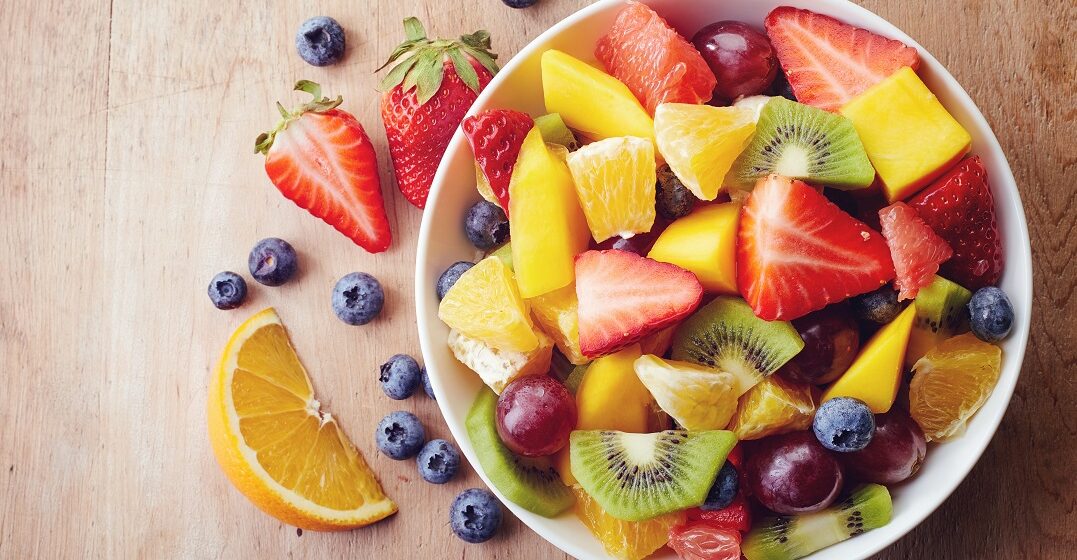by Anne Walther
Published on April 24, 2023
When thinking about a tropical country, Germany may not be the first one to pop to mind. Still, it has some amazing and sweet fruits to offer – some better known and others of which you may have never heard. Especially when you find yourself at a German farmer’s market, you may be surprised at the variety of fruits the stands have to offer. But of course, to buy yourself some of those healthy snacks, you will need to learn their German names. Well, you are in luck: here they are!
der Apfel – die Äpfel
A classic among the German fruits! Try it in an apple crumble or combined with Kartoffelpuffer.
die Birne – die Birnen
Did you know? Pears not only have delicious fruit, but the trees also provide great wood to build furniture.
die Orange – die Orangen or die Apfelsine – die Apfelsinen
Christmas time usually is when Germans consume oranges the most and they use them to make mulled wine known as Glühwein, a delicious drink you can find at any German Christmas market.
die Mandarine – die Mandarinen
Much like their larger siblings, the smaller mandarin oranges are also typical around Christmas time, so much so that people buy them in large wooden boxes.
die Banane – die Bananen
For Germany, bananas are not only a delicious and healthy snack – their juice is also combined with wheat beer to make the summer drink Bananenweizen.
der Pfirsich – die Pfirsiche
The name peach and the German Pfirsich both relate to the history of peaches and stem from its original name: the Persian apple.
die Aprikose – die Aprikosen or die Mirelle – die Mirellen
Apricots are the center of the annual Mirellenfest in Krems in Austria, where you can eat many different types of food with apricots as the main ingredient.
die Pflaume – die Pflaumen or die Zwetschge – die Zwetschgen
Plums have a long history of cultivation in Germany and are an important ingredient in many traditional foods, such as Zwetschgenknödel.
die Mirabelle – die Mirabellen
Mirabelle plums are smaller than usual plums and yellow in color.
die Kirsche – die Kirschen
Cherries are another beloved fruit in German households. And Germans not only eat but cultivate both sweet and sour varieties of this product. Particularly in the east, you can sometimes find small public cherry plantations.
die Stachelbeere – die Stachelbeeren
Germany is the largest producer of gooseberries worldwide and is responsible for almost half of the world’s harvest.
die Quitte – die Quitten
Quinces are similar to apples in taste, but due to their firmness, it is best to eat them only cooked or as jelly.
die Erdbeere – die Erdbeeren
During summer, some strawberry plantations in Germany allow you to go to the field and pick your own harvest.
die Himbeere – die Himbeeren
Raspberries are not only delicious but their leaves are also used in traditional medicine to treat stomach problems and inflammations.
die Brombeere – die Brombeeren
Similar to raspberries, blackberry leaves are known to be useful against inflammations.
die Heidelbeere – die Heidelbeeren or die Blaubeere – die Blaubeeren
Blueberries can be found in the wild, particularly in pine forests and are known in traditional medicine to help against diarrhea.
die Kiwi – die Kiwis
Kiwis never was a common fruit choice in Germany. At least not until 1970, when its consumption rose from 900.000 to more than 85 million within only 9 years.
die Ananas – die Ananasse
Did you know? Unlike many other fruits, pineapples don’t continue to ripen after harvest.
die Johannisbeere – die Johannisbeeren
Currants are not only used as food, but the flowers of black currants are also an ingredient in perfumes.
die Weintraube – die Weintrauben
Although Germany is not a very famous wine country, grapes are grown in many different regions and many festivities around wine exist.
Here you can also find a list of all fruits and their German names:
| the apple | der Apfel |
| the pear | die Birne |
| the orange | die Orange |
| the mandarin orange | die Mandarine |
| the banana | die Banane |
| the peach | der Pfirsich |
| the apricot | die Aprikose |
| the plum | die Pflaume |
| the mirabelle plum | die Mirabelle |
| the cherry | die Kirsche |
| the gooseberry | die Stachelbeere |
| the quince | die Quitte |
| the strawberry | die Erdbeere |
| the raspberry | die Himbeere |
| the blackberry | die Brombeere |
| the blueberry | die Heidelbeere |
| the kiwi | die Kiwi |
| the pineapple | die Ananas |
| the currant | die Johannisbeere |
| the grape | die Weintraube |
All this talking about fruit surely can get you in the mood for a healthy snack – and you are now more than ready to shop for fruits in German! To find the best quality, make sure you do not stop at supermarkets only but scan local farmers’ markets too.
